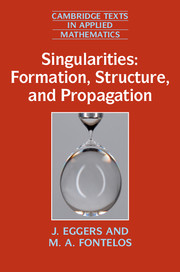Book contents
- Frontmatter
- Dedication
- Contents
- Preface
- PART I SETTING THE SCENE
- 1 What are singularities all about?
- 2 Blowup
- 3 Similarity profile
- 4 Continuum equations
- 5 Local singular expansions
- 6 Asymptotic expansions of PDEs
- PART II FORMATION OF SINGULARITIES
- PART III PERSISTENT SINGULARITIES: PROPAGATION
- Appendix A Vector calculus
- Appendix B Index notation and the summation convention
- Appendix C Dimensional analysis
- References
- Index
4 - Continuum equations
from PART I - SETTING THE SCENE
Published online by Cambridge University Press: 05 September 2015
- Frontmatter
- Dedication
- Contents
- Preface
- PART I SETTING THE SCENE
- 1 What are singularities all about?
- 2 Blowup
- 3 Similarity profile
- 4 Continuum equations
- 5 Local singular expansions
- 6 Asymptotic expansions of PDEs
- PART II FORMATION OF SINGULARITIES
- PART III PERSISTENT SINGULARITIES: PROPAGATION
- Appendix A Vector calculus
- Appendix B Index notation and the summation convention
- Appendix C Dimensional analysis
- References
- Index
Summary
General ideas
This book deals for the most part with partial differential equations, whose basis is to view the world as a continuum. This agrees with our perception of liquids, gases, and many solids; they appear to have no characteristic structure and are perfectly isotropic: no property is linked to a particular point or direction in space. We hasten to add that the reality is often more complicated. A liquid may contain components which possess a significant microstructure, e.g. polymers. Solids are often crystalline, which means that their properties depend on the direction of observation relative to the crystal axes.
It is worth remembering the complexity of any microscopic description of a liquid, gas, or solid, even if the system is extremely small. Consider, for example, the computer simulation of a liquid jet emerging from a nozzle only 6 nm in diameter, shown in Fig. 4.1. Each molecule of the liquid is treated as a mathematical point, with a known force between any two molecules. At very small distances, the molecules repel; at larger distances, they attract. The balance between attraction and repulsion causes the molecules to condense into a liquid state. Even on a scale of a few nanometers, the jet appears essentially like a continuum.
The simulation shown in Fig. 4.1 was obtained by solving Newton's equations for each molecule, taking into account the forces exerted on it by the other molecules. This is feasible for a few hundred thousand molecules by only including interactions with molecules close to the target particle. Thus, from a microscopic point of view, we have an incredibly complicated system of nonlinear ODEs. The only hope of gaining analytical insight lies in developing a continuum description. Here we will emphasize the basic physical principles on which the continuum description of fluids and solids relies, and briefly develop the equations of motion on which the rest of this book is based.
The Navier–Stokes equation
The continuum description of liquids and gases is based on the fundamental laws of conservation of matter and of momentum. Here anything that flows is usually called a fluid and comprises both liquids and gases described by the same flow equations.
- Type
- Chapter
- Information
- Singularities: Formation, Structure, and Propagation , pp. 63 - 88Publisher: Cambridge University PressPrint publication year: 2015



